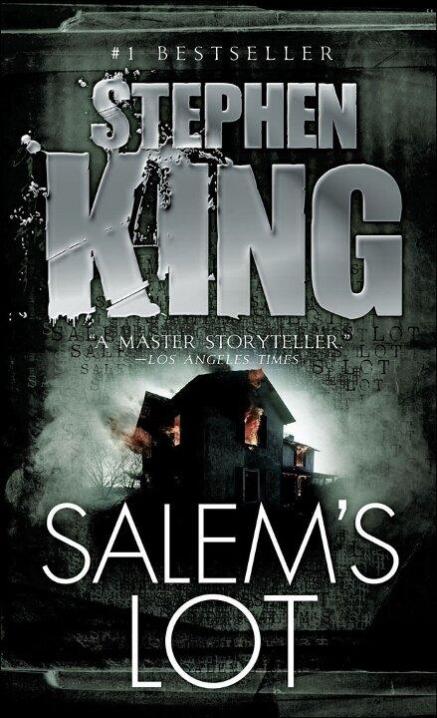
I’ve finally felt the Stephen King bug again, so I’m going to review another classic, ‘Salem’s Lot. It is a vampire story, and one with a lot of promise. The novel follows Ben Mears, who in true Stephen King fashion, happens to be a writer. He returns to Jerusalem’s Lot, Maine, the town where he grew up. After the abandoned Marsten House is bought by the mysterious Kurt Barlow, disappearances begin to occur and gradually vampirism spreads around the town, starting with the young boy Danny Glick. Ben and several other townspeople develop a resistance against the growing number of vampires but they soon become outnumbered and the question is raised as to whether the town can even be saved.
Put simply the book basically deals with a vampirism epidemic, with Kurt Barlow being the Dracula esque figure at the head of it all. The fact that the book focuses on the growing epidemic, as opposed to a smaller conflict with just Barlow himself, is one I greatly enjoyed since it portrayed perfectly just why vampires are a threat, and by extension why Barlow is a threat. It goes out of its way to show that even without Barlow, the vampires are dangerous and certainly aren’t the nice human like creatures you see in Twilight and other modern vampire novels.
Barlow himself is nothing too special, being essentially like Dracula. Yet he still commands a compelling presence, showing that the powerful Dracula like vampire still has a place in horror fiction even in a relatively modern piece of literature such as ‘Salem’s Lot. There are interesting aspects to Barlow and the other vampires of the setting, especially with regards to strengths and weaknesses. Barlow and the other vampires appear to have most of the traditional vampire strengths and weaknesses, but there are a few twists which make the experience fresh. For example, holy symbols only work against vampires if the person using them has faith. The young Mark Petrie is able to use a cross to fend off Danny Glick by using a cross, but Father Callahan, who is having a crisis of faith, is unable to fend off Barlow with his cross during his confrontation with him.
A lot of the characters as a whole are similar to the ones seen in other King novels, with younger characters such as Mark Petrie and Danny Glick being reminiscent of younger characters from other novels, including It though he does get a slight exemption since this is only his second work. Susan, Ben’s love interest, likewise doesn’t seem all too different to King’s other love interest characters though, again, since she is probably the first such character to my knowledge she also gets let off to some extent. However her death was a good twist and one that made me realise that the story wasn’t going to get your traditional happy ending. Most of the other characters seemed to fall under the radar, as most of them existed for the purpose being victims of the vampire epidemic though they all felt like real characters for the duration they were on the page, which is one of Stephen King’s best skills. The one good thing of Stephen King is that he can get you to care about the characters, even if they are going to die in the same chapter in which they are introduced. Since all characters are well developed, it makes it hard to gauge who is going to survive until the end since several victim characters get focus in the beginning, while some seemingly minor characters become more prominent as they survive the book’s events.
Yet the most clever part of this book is without a doubt the end. It is hinted in the novel’s frame narrative, shown in a prologue, that the story didn’t end happy but nothing prepared me for what extent. The novel progresses in a Dracula fashion, with the group seeking to kill Barlow in order to end the vampire threat. Yet, in one of the most clever twists, Barlow’s death does nothing to stop the multitude of other vampires in the town. As a result Ben and the young Mark are forced to flee, abandoning the town to the leaderless vampires. It isn’t until the epilogue, which returns to the frame narrative, where the novel finally gets some closure when Ben and Mark return to Jerusalem’s lot and burn it to the ground. As clever as it was, I did wonder if it was necessary for them to abandon the town. Maybe they could have just set the bush fire just as they were leaving, since surely this would kill off the vampire population before they can spread to nearby settlements. Other than that, the novel ended well in my opinion.
The book is probably one of my favourite vampire stories and certainly a return to the genre’s roots. It is traditional yet at the same time it is told in such a way that it feels brand new despite this. This is the novel which makes vampires scary again, and though it isn’t my favourite Stephen King book, objectively speaking it is a great book without a shadow of a doubt. I don’t tend to read many vampire stories, but I can’t help but feel that vampires aren’t taken as seriously as they used to be. It makes me wish other vampire stories would take inspiration from this book, that way I might finally be able to take vampire stories seriously again.
SCORE: 4/5
IN A WORD: REFRESHING